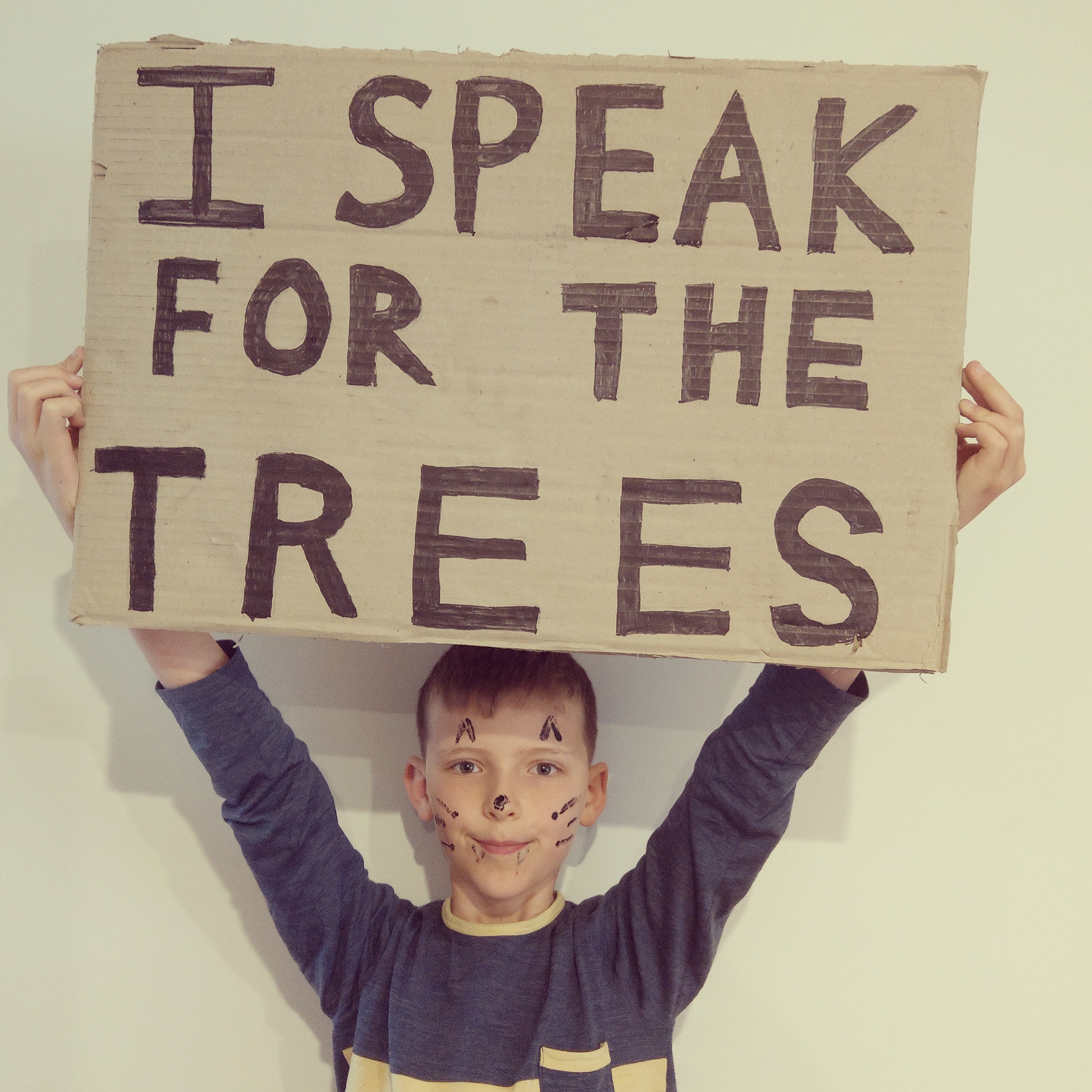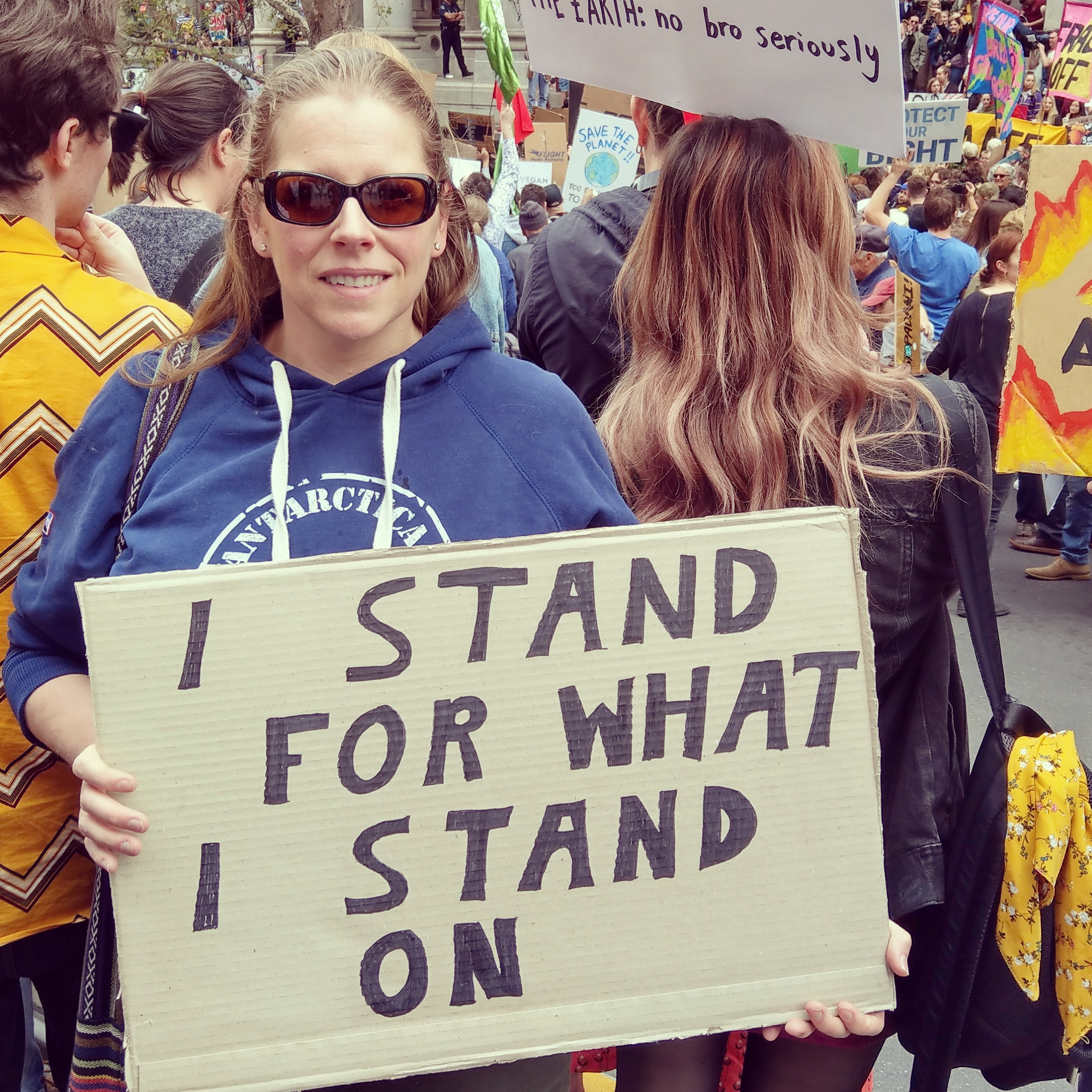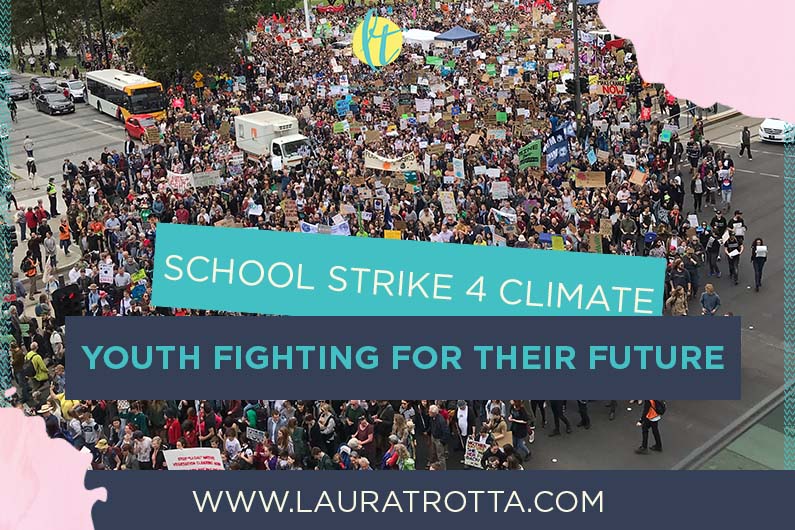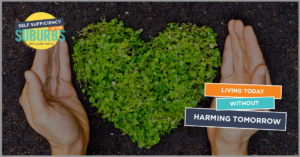In 2018, after experiencing Sweden’s hottest summer on record, a 15-year-old Greta Thunberg protested alone outside the Swedish parliament with a sign saying “School Strike for Climate”, to pressure her government to meet carbon emission targets. Within a few short months millions of students would follow her lead, taking Fridays off school to protest for climate action.
Before too long the movement came to my home city of Adelaide. On 20 September 2019, tens of thousands of students and adults marched together from Victoria Square to Parliament House.
I was one of them.
In the days leading up to the protest I told my sons I was going and asked if they wanted to come. My eldest son Matthew, who was just nine years old at the time, was excited to join me until his school scheduled an entire school excursion to a fabulous nature play conservation park on the day of the protest, to celebrate the school’s 60th birthday.
I gave him the choice and said I’d support him to do either.
But he couldn’t choose. Have fun playing with his friends in nature (aka being a kid) or attend a climate rally with his mum. He said he knew the rally was more important, but he just couldn’t decide.
So I made the decision for him.
I said “how about you go on the school excursion with your friends and I’ll go to the strike and will carry your sign so your message is heard. There’ll be another climate rally you can join mum on.” He liked that idea.

Matthew (aged 9 years) holding the banner he helped make for the September 2019 School Strike 4 Climate march in Adelaide, South Australia. Myself and a friend carried the banners at the rally on behalf of him and his generation.
I posted on my social media at the time that I loved the momentum and attention the school strike 4 climate movement is attracting, however I think it’s really unfair that our kids feel the weight of the world. They know the issues. They see the damage. And they worry about their future.
I worry about their future too.
Which is why I took that day off work without pay to join the school strike for climate march as an ADULT, demanding that other ADULTS take the required action to address the climate crisis.
Now, almost three years on, the School Strike 4 Climate movement has evolved but is just as strong as ever. My son Matthew is now 12 years old and is still a kind, sensitive boy concerned about climate change. When he was tasked recently with a school assignment to interview someone who is using their voice for good for an issue he’s passionate about, he only wanted to research climate change action.
Enter Lola Stravoskoufis.
Lola is a Year 9 student from Exeter in the Southern Highlands region of NSW. She marched as a Year 6 student in the large student climate strikes in 2019 and subsequently joined the School Strike 4 Climate movement. She now leads the School Strike 4 Climate group in her regional town and is actively meeting with her local candidates for the upcoming Federal election to ensure the voice of youth is heard loud and clear.
In this episode my son Matthew will interview Lola, uncovering the information he needs to include in his school assignment, but also educating himself more in how students, not too much older than him, are making a really big impact in climate change awareness.
Lola will share what the School Strike 4 Climate movement is and why she decided to join, when and how it was founded, and the impact the movement is having.
Podcast: Play In New Window
Subscribe in: Apple Podcasts | Stitcher | Spotify | Amazon Music
Resources:
What is School Strike for Climate?
Well, firstly, I’d just like to acknowledge that I am Zooming in from Gundungurra land, the Southern Highlands. So School Strike 4 Climate is a student led organisation and School Strike 4 Climate works internationally and also on a national level. So in Australia we have our national team of School Strike 4 Climate students and then on more of a local level, the cities in Australia, and also in smaller towns, we’ve got local groups who work together to organise those actions. Like the strikes, you’ll see a lot of the time and other climate justice related actions.
What led to you getting involved with School Strike for Climate?
I’m from a regional area, just south of Sydney and I have seen natural disasters every single year get worse and worse in my area. Obviously the 2019/ 2020 summer bush fires were devastating for people all over Australia. In my area specifically, we were very lucky to go mostly unscathed, there were quite a lot of properties that were damaged and destroyed. But just during that period, the terror we all felt, not knowing if we’d be able to come back to a standing house, that was really, really terrifying and quite heartbreaking.
Then more recently with the floods, that’s also been extremely terrifying for all of us. For me, I was lucky enough to have my house survive and we weren’t too affected by the floods. I can’t say the same for some of my friends, who live up in the Lismore area who really felt that. I’m sure you’ve seen all the stuff that happened up in Lismore and how horrible it was. But not being able to get to school because of the floods, that was where it clicked for me. Because we weren’t able to get to school, we were getting pulled home from school, it was all really crazy.
Seeing how those natural disasters have affected my town, have affected my community, my family. That was a really big deal for me and that’s part of the reason why I joined, because every single year, those natural disasters are getting worse and worse. It’s extremely important that we act now rather than later, to prevent those disasters from just getting worse and worse and more threatening into the future. I went to my first climate strike in year six and I’ve gotten more or involved over the last year.
I emceed a climate strike in Bowral, which is one of the bigger towns in Southern Highlands where I lived, about this time last year. That was kind of like, oh, maybe I could do more with this and then I went to one of the online climate strikes, the October 15th climate strikes. From there I was like, maybe I should sign up and I did. I’m so glad I did, because at that point, now I’ve joined and I’ve started up my own local group in my area. So I’m working both nationally to prepare stuff for local groups and then on a local level to prepare the actual strikes, which is really great.

Lola emceeing a climate rally in Bowral, NSW in 2021
Who leads the Australian School Strike 4 Climate Organisation?
The Australian School Strike 4 Climate Organisation actually isn’t led by one person in particular. We’re a student led organisation, meaning that we don’t really have one specific leader. It’s essentially just a bunch of students working together from all over the country, working as one to try and achieve climate justice. So we don’t have one person who we refer to as our leader, we all work together and it’s very equal the way we work. So no specific leader, just a bunch of students who have one common goal and want to try and achieve that together.
I’ve loved working with youth workers over the past year. I was a part of a regional youth task force last year here in New South Wales, where it was essentially 18 young people from all over regional areas in New South Wales, advising the government on issues that affect us.
Working in that kind of sector would be really, I think I love that sort of stuff. I feel in School Strike there’s that whole thing with really making sure that regional voices are heard and we do a really great job of that, I feel now. In the past it hasn’t been as much, but over the last couple years I feel School Strike’s really grown to a movement that isn’t just Sydney and Melbourne based strikers. We have local groups all over regional Australia, which is really, really fantastic. So making sure your voice as a regional organiser is put forward, has always been a really important thing to me, because it’s not always as simple as you might think it is. There’s people who are organising strikes and you kind of sit back and you say to yourself, “Well, is this going to work for a small regional town that’s very conservative? Probably not.” We’re making such big steps in that kind of area at the moment, which is really amazing.
When was the Australian School Strike 4 Climate Organisation founded?
The first strikes in Australia happened in late 2018, which was when the movement was founded. Essentially a bunch of students got together and decided that they weren’t seeing climate action being taken. It was very important to them that this action was going to be taken and so School Strike essentially was formed. These students were obviously very inspired by Greta Thunberg and her work and her school strikes outside Swedish Parliament House. So it was in 2018 when those first happened and you’ll have seen over the past five years, those strikes are getting more and more prominent and you’ll see them a lot in the news, you’ll see school strikers standing up and speaking up. But 2018 was where it all started, which was really fantastic.

Me at the September 2019 School Strike 4 Climate march in Adelaide, South Australia
Who foundED the Australian School Strike movement?
The movement wasn’t founded by one person in particular, it was just a bunch of students from all over coming together and saying, “Look, we need climate justice now. The government’s not taking us seriously enough. Let’s start this movement together and make sure that our futures are taken seriously.” So again, it wasn’t really one person in particular. It was just a bunch of kids who were really, really angry with what wasn’t being done. With the support from adult supporters and other organisations over the years, it’s just grown to what it is now. Where it is an international organisation with an Australian branch of School Strike 4 Climate. It was just a bunch of really, really angry kids, who were just like, “Let’s take our futures into our own hands now and do something about it.”
How is the organisation connected to Greta Thunberg and her work?
So Greta obviously is amazing and she has been striking school outside of Swedish Parliament House for years now. So obviously School Strike Australia were very inspired by what she was doing as a school student. Greta and a lot of other students, they essentially formed Fridays for Future, which is an international climate organisation, which School Strike 4 Climate is linked to. So when you see those international strike days, they’re kind of organised by Fridays for Future and School Strike is almost under that one. So we strike on international school days, which are organised by Fridays for Future as well as the other climate organisations and also, on our own strike days. But the way we just were all so inspired by what she was doing and what other students all over the world were doing. So we looked at that and formed our own movement.
What impact has the organisation achieved since inception?
School Strike 4 Climate has had such a massive impact. You’ll see a lot new stories featuring school strikers and everything that they’ve been doing has just been amazing. I feel over the last few years, the amount of awareness that’s been raised about this issue is phenomenal. In regards to how many students have participated in strikes internationally, millions of students have. In Australia, we’ve had strike days in the past where over 300,000 people have participated in strikes nationally in over 100 events, which is phenomenal. That was on September 20th in 2019, we had over 300,000 young people, their families, their communities, other people in the climate justice movement, all march to demand the government take our future seriously. Which is pretty phenomenal and it’s amazing that they were able to do that.
More recently, you may have seen the March 25 climate strikes, which were held in around 20ish locations across Australia. We had numbers in estimated to be around 5,000. So not as big, but at the same time, that’s also a massive impact that we had. I do know that Sydney strike that happened, they had over 3,000 people attend that one. That was pretty amazing and just seeing that many people or that many young people, especially all striking for one thing is a pretty impactful thing on its own. So that’s kind of the impact that we’ve had.
What’s next for School Strike 4 Climate?
We have a lot of actions currently planned, leading into the next federal election. The federal election is on May 21st and School Strike has been busily preparing for all of our actions. You’ll see there are some local groups in School Strike 4 Climate that are planning school walkouts. So essentially a bunch of students will walk out of school on one day, demanding that the government take action on climate change. We’ve obviously got our strikes that you’ll see around here and there. There’s ones in Sydney coming up, there’s ones in Armidale coming up. A lot of different places have strikes in the new next couple of weeks. So that’s pretty amazing.
We’ve also got community climate forums, which entail inviting a bunch of candidates and MPs to one space, where the young people can ask them questions on their plans for tackling climate change. Which is always a really fun one to do and talking with MPs and candidates is always extremely impactful. Another one in regards to MPs, is the idea of actually meeting with those MPs and candidates, which I’ve done a few times myself. Those are always really great, because while they’re not as big and loud as events like strikes or school walkouts are, they do have quite a big impact, because you’re actually talking face-to-face with a political candidate or an MP about what you need and your desire to see that change happen.
The other action that you’ll see here and there is MP training, which is essentially a bunch of students who go outside an MP office and make a bunch of noise. It’s almost planned, as almost a school day, so it’s teaching that MP about climate change. It’s a very theatrical event and it’s very fun and it’s really entertaining to actually watch as well.
So those are some of the actions we have planned for the next month or so. It does get very hard at times reaching out to politicians and trying to get them to meet with us, and then never getting a response from them. That kind of shows quite a lot about a politician. I’m also based in a very Liberal safe seat and I’ve been doing a lot of work recently with my local group, trying to meet with my local MP and the candidates from the federal election. I didn’t get a response from my Liberal MP, which is Angus Taylor and I’ve heard that he actually hasn’t been showing up to any of the election candidate forums either, but I’ve been lucky enough to meet with some amazing candidates. So I met yesterday with the Greens candidate. I met with an independent a couple of weeks back who I’m now working closely with, not as a School Strike organiser, but as a young activist, which has been really fun.
So I mean, there’s good people out there. We just got to try and get them elected. I’m trying to plan at the moment a youth forum, which is going to be with all our candidates and our local member. Where young people will be able to come to together and question these adults, essentially, which the planning for this is so exciting. I’m actually so excited for that, because it’s going to be so cool. Just the thought of having a bunch of students in a room together, like-minded students in a room with a bunch of political candidates. That’s pretty amazing to me. So I love these climate forums and everything, with getting people into question, like candidates and MPs. So it’s really cool to see people actually say, “You know what? You’re actually not doing much. Let me call you out on it, because I feel like that’s not always done.”
I love seeing those people who just are not scared to give it a go and call those politicians out and stuff, because it’s always just amazing. In regards to after the election, we are in the process of planning some other actions, tackling some bigger organisations. We’re looking towards having other strikes in the future, hopefully those strikes will also have as big of an impact as some of the more recent strikes have had. I’m sure they will, because people are, I feel young people are so ready to go in this situation. We’re all angry, I’m sure you know, at the government for not taking action on climate change. So young people are rearing and ready to go, which is really amazing to see.
OVER TO YOU
If you’re ready to reduce your emissions, your household waste, live toxin-free and embrace a more sustainable lifestyle with the support of Laura, join the Self Sufficiency in the Suburbs community.
If you’re ready to reduce your emissions, your household waste, live toxin-free and embrace a more sustainable lifestyle with the support of Laura, join the Self Sufficiency in the Suburbs community today!
Like this episode? You’ll also love….
[67] Climate Change – What it is and Why We Need to do Something About It
[135] Climate Change and YOU – 8 Things You Can Do to Combat Climate Change
[142] Why are Councils Declaring a Climate Emergency?
[147] How Climate Change is Fuelling Bushfires
[155] How to Offset Your Carbon Emissions
[164] Climate Change and the Human Health Impact
[165] Teaching Kids About the Climate Crisis
[171] Engineering Solutions to Climate Change
- Sustainable Home Design- factors to consider to maximise sustainability - July 28, 2022
- Advantage and Disadvantages of Tiny Houses - May 31, 2022
- How School Strike 4 Climate is Empowering Youth to Fight for Their Future - May 1, 2022



 Laura Trotta is one of Australia’s leading home sustainability experts. She has a Bachelor of Environmental Engineering, a Masters of Science (in Environmental Chemistry) and spent 11 years working as an environmental professional before creating her first online eco business, Sustainababy, in 2009. She has won numerous regional and national awards for her fresh and inspiring take on living an ‘ecoceptional’ life (including most recently winning the Brand South Australia Flinders University Education Award (2015) for the north-west region in SA and silver in the Eco-friendly category of the 2015 Ausmumpreneur Awards). With a regular segment on ABC Radio and with her work featured in publications like Nurture Parenting and My Child Magazine, Laura is an eco thought leader who’s not afraid to challenge the status quo. A passionate believer in addressing the small things to achieve big change, and protecting the planet in practical ways, Laura lives with her husband and two sons in outback South Australia.
Laura Trotta is one of Australia’s leading home sustainability experts. She has a Bachelor of Environmental Engineering, a Masters of Science (in Environmental Chemistry) and spent 11 years working as an environmental professional before creating her first online eco business, Sustainababy, in 2009. She has won numerous regional and national awards for her fresh and inspiring take on living an ‘ecoceptional’ life (including most recently winning the Brand South Australia Flinders University Education Award (2015) for the north-west region in SA and silver in the Eco-friendly category of the 2015 Ausmumpreneur Awards). With a regular segment on ABC Radio and with her work featured in publications like Nurture Parenting and My Child Magazine, Laura is an eco thought leader who’s not afraid to challenge the status quo. A passionate believer in addressing the small things to achieve big change, and protecting the planet in practical ways, Laura lives with her husband and two sons in outback South Australia. 


